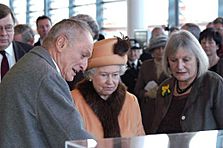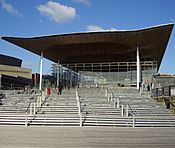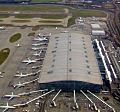Richard Rogers facts for kids
Quick facts for kids
The Lord Rogers of Riverside
|
|
|---|---|
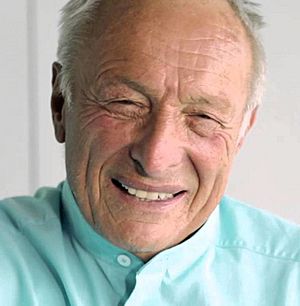
Rogers in 2013
|
|
| Born |
Richard George Rogers
23 July 1933 Florence, Tuscany, Italy
|
| Died | 18 December 2021 (aged 88) London, England
|
| Nationality | British and Italian |
| Alma mater |
|
| Occupation | Architect |
| Spouse(s) | |
| Children | 5, including Roo |
| Awards |
|
| Practice | Rogers Stirk Harbour + Partners (2007–2020) |
| Buildings |
|
| Projects |
|
Richard George Rogers, Baron Rogers of Riverside (23 July 1933 – 18 December 2021) was a famous British-Italian architect. He was known for his modern and functional designs, often called "high-tech architecture." He led the architecture firm Rogers Stirk Harbour + Partners until 2020.
Rogers designed many famous buildings around the world. These include the Pompidou Centre in Paris and the Lloyd's building in London. He also designed the Millennium Dome in London and the Senedd building in Cardiff. He won many top awards for his work, like the Pritzker Architecture Prize, which is architecture's highest honor.
Richard Rogers' Early Life and Education
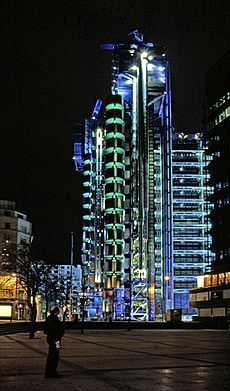
Richard Rogers was born in Florence, Italy, in 1933. His family moved to England in 1938 to escape the difficult political situation in Italy.
Growing up, Richard found school challenging. He struggled with reading and memorizing his schoolwork. He later realized he had Dyslexia, a learning difference that affects reading. This discovery helped him understand his early school struggles.
After school, he served in the military for two years. Then, he went to the Architectural Association School of Architecture in London. He later earned a master's degree from the Yale School of Architecture in the United States.
While at Yale, he met fellow architecture student Norman Foster. They became good friends and later worked together.
Starting His Architecture Career
After finishing his studies, Rogers worked in New York City. In 1963, he returned to England. He, Norman Foster, and Su Brumwell (who later married Rogers) started an architecture firm called Team 4. This group became known for their "high-tech architecture." This style often shows off the building's structure and systems on the outside.
By 1967, Team 4 split up, but Rogers continued to design. He worked on a house for his parents in Wimbledon, based on his ideas for a "Zip-Up House." This design focused on using parts that could be put together easily.
Later, Rogers teamed up with Italian architect Renzo Piano. Their partnership was very successful. They won a competition to design the Pompidou Centre in Paris in 1971. This project made them famous around the world.
Later Career and Big Ideas
After working with Piano, Richard Rogers started his own firm in 1977. It was first called the Richard Rogers Partnership and later became Rogers Stirk Harbour + Partners. This company has offices in major cities like London, Shanghai, and Sydney.
Rogers cared a lot about how cities are built and used. He thought about how to make them sustainable and beautiful. In 1986, he held an exhibition called "London As It Could Be." It showed ideas for improving large parts of central London.

In 1995, he gave a series of talks for the BBC called "Sustainable City." These talks were later turned into a book, Cities for a Small Planet. He discussed how cities could be designed to be better for people and the environment.
Rogers also advised the British government on urban planning. He led a group called the Urban Task Force. This group looked at why cities decline and how to make them safer and more vibrant. Their ideas were published in a report called Towards an Urban Renaissance.
He also advised the Mayor of London on architecture and urban design for many years. He helped shape how London developed. He also gave advice to the mayors of Barcelona on city strategies.
Famous Projects and Challenges
Rogers continued to design many important buildings. One of his most famous projects was the Millennium Dome in London, completed in 1999. It was a huge building designed for a special exhibition.
In 2006, his firm was chosen to design Tower 3 of the new World Trade Center in New York City. This was a very important project after the events of September 11.
Richard Rogers retired from his firm in 2020. The firm will eventually remove his name from its title.
Key Architecture Projects
Richard Rogers worked on many different projects throughout his career. Here are some of his most notable works:
Team 4 Projects
- Creek Vean, Cornwall, UK (1963–1966)
- Reliance Controls factory, Swindon, UK (1967)
- Jaffe House, Maldon, UK (1965–1966)
Richard and Su Rogers Architects Projects
- 22 Parkside (Rogers' parents' house), Wimbledon, London, UK (1967)
- Zip-Up House (1967–69)
Piano + Rogers Projects
- Pompidou Centre, Paris, France (1971–77)
- PA Consulting Group's Research Laboratory, Melbourn, UK (1976–1983)
The Richard Rogers Partnership Projects
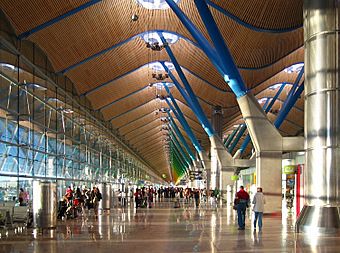
- Lloyd's building, London, UK (1978–84)
- Inmos microprocessor factory, Newport, Wales, UK (1980–1982)
- European Court of Human Rights building, Strasbourg, France (1995)
- Millennium Dome, London, UK (1996–1999)
- Senedd building, Cardiff, Wales (1999–2005)
- Adolfo Suárez-Madrid Barajas Airport terminals 4 and 4S, Madrid, Spain (2004)
Rogers Stirk Harbour + Partners Projects
- Heathrow Terminal 5, London, UK (1989–2008)
- Las Arenas, Barcelona, Spain (1999–2011)
- Maggie's Centre, London, UK (2001–2008)
- Central Park Station (R9), Kaohsiung City, Taiwan (2003–2007)
- Three World Trade Center, New York City (2006–2018)
- 122 Leadenhall Street, also known as the Cheesegrater, London (2000–2014)
- International Towers Sydney, Barangaroo, Sydney (2010–2016)
Challenges and Criticisms
Some of Rogers' buildings faced challenges. For example, the Lloyd's building in London was designed with its pipes and services on the outside. This unique design led to high maintenance costs because these parts were exposed to the weather.
In 2014, there were also complaints about water leaks at the Oxley Woods housing estate. These issues show that even innovative designs can have practical difficulties.
Richard Rogers' Personal Life
Richard Rogers was married to Ruth Rogers, who is a famous chef. They had two sons together. He also had three sons from his first marriage. He had many grandchildren.
He passed away in London on December 18, 2021, at the age of 88.
Awards and Recognitions
Richard Rogers received many honors for his contributions to architecture. In 1991, he was made a Knight Bachelor by Queen Elizabeth II. In 1996, he became Baron Rogers of Riverside, which allowed him to be a member of the House of Lords, part of the British Parliament. He was also made a Member of the Order of the Companions of Honour in 2008.
He won the RIBA Royal Gold Medal in 1985. France also honored him twice for his work. In 2007, he received the Pritzker Architecture Prize, which is considered the highest award in architecture.
His firm won the Stirling Prize twice. Once in 2006 for the Barajas Airport terminal in Madrid, and again in 2009 for the Maggie's Centre in London. In 2006, he also won the Gold Medal for Architecture in Wales for his design of the Senedd building.
In 2012, Richard Rogers was included in a special artwork by Sir Peter Blake. This artwork was a new version of the famous Beatles' album cover, Sgt. Pepper's Lonely Hearts Club Band. It celebrated important British cultural figures from the last six decades.
Rogers also received honorary degrees from several universities around the world.
Images for kids
See also
 In Spanish: Richard Rogers para niños
In Spanish: Richard Rogers para niños


